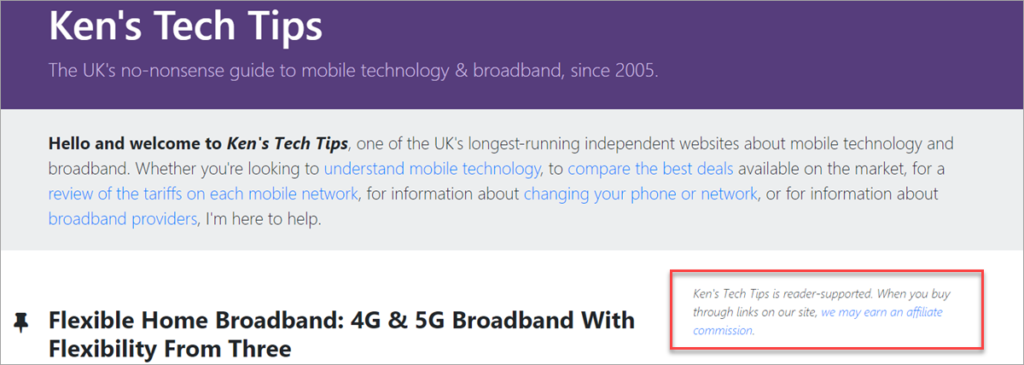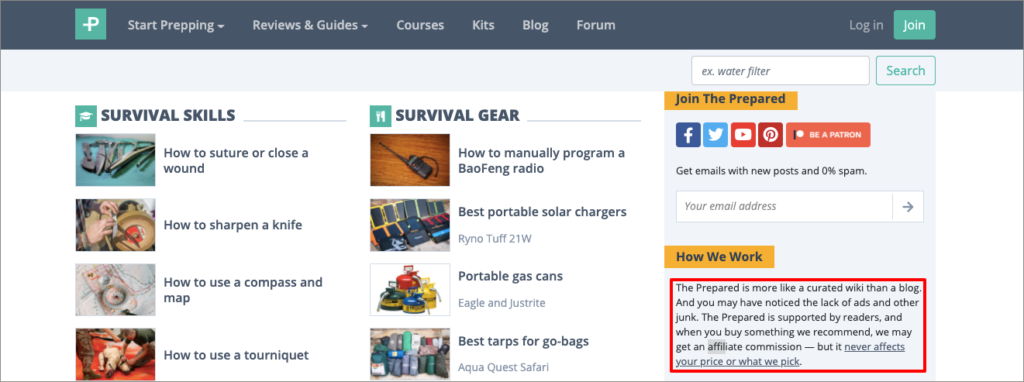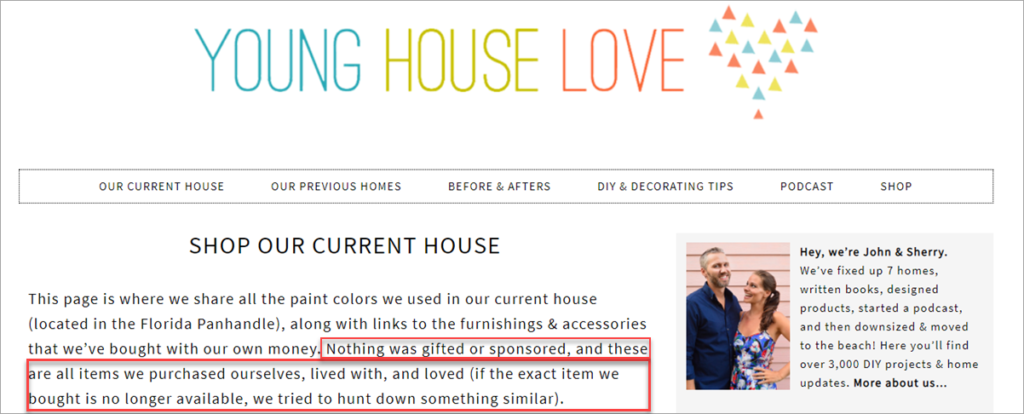In 2009, the FTC (Federal Trade Commission) introduced its guidelines on affiliate disclosure to ensure that consumers were fully aware of any financial relationship between a website and the products or services they might recommend via endorsements or testimonials.
Up to this point, consumers had no idea if the site they were browsing was being financially compensated for featuring specific products.
The guidelines ensure that website owners/affiliate marketers offer their visitors full transparency in relation to such commercial relationships.

Now, every affiliate marketer and social influencer has to use an affiliate disclosure of some kind.
In this article, we will explain best practices in relation to them.
As well as giving you affiliate disclosure example examples to get your creative juices flowing.
Basically, everything you need to know about affiliate disclosures.
What is an Affiliate Disclosure?
Affiliate link disclosures serve as a form of disclaimer, informing users that when they click on an affiliate link within a blog post or landing page and proceed to make a purchase, the site owner will receive a commission. These disclosures emphasize the existence of affiliate relationships and allow consumers to enter transactions with full awareness.
Importantly, affiliate link disclosures aren’t just a “nice thing” to include on your affiliate site — they’re actually mandated by the US Federal Trade Commission. No one wants the FTC breathing down their neck, so you must understand your requirements!
So how should you be using affiliate link disclosures on your website?
Well, the FTC offers the following advice to affiliate marketers:
“If you disclose your relationship to the retailer clearly and conspicuously on your site, readers can decide how much weight to give your endorsement.”
In practice, a single affiliate link disclosure may be sufficient, such as when affiliate links are embedded in product reviews. That way, the reader sees the affiliate disclosure and the link at the same time.
On the other hand, if the affiliate disclosure and the link itself are separated, users may not recognize the connection.
This means there’s less chance they’ll understand your links are tied to affiliate relationships — and the FTC definitely doesn’t like that.
Why Do You Need an Affiliate Link Disclosure?
Let’s say you visit a travel blog, and they recommend a specific hotel as being the best in X city.
A city you just happen to be visiting soon.
So you click on their link, book yourself a room, and fly to your destination.
But when you check in, you suddenly realize the hotel is still under construction.
In the middle of a swamp.
It’s at that point you realize you were scammed by the travel blogger, as was everyone else who clicked on their affiliate links.
Because the only way anyone could recommend Hotel Hell is if they were paid to do that.
And that’s when the penny finally drops.
Your holiday is ruined, and the dishonest travel blogger deletes their blog post and plays dumb.
This is exactly the type of scenario that the FTC guidelines aim to curb or eradicate.
So while they might seem unnecessary, they’re actually just about providing consumer protection by preventing shady business practices.
The Guides, at their core, reflect the basic truth-in-advertising principle that endorsements must be honest and not misleading.
An endorsement must reflect the honest opinion of the endorser and can’t be used to make a claim that the product’s marketer couldn’t legally make.
Source: FTC
The goal is to ensure that bloggers and social influencers are upfront about any actions that could influence a consumer’s decision-making process.
And anything that does so via affiliate links requires an affiliate disclosure.
Basically, you need to use an affiliate link disclosure because dishonest marketers are willing to endorse products that aren’t fit for purpose.
Solely because they were offered a lot of money to do that.

There’s also the fact that most people have no idea what affiliate marketing is.
This is why your affiliate link disclosure should specifically state that you will receive payment for recommending a given affiliate marketing program.
But there’s a fringe benefit in all of this because you’re offering full transparency to your visitors.
They know you may receive financial compensation for recommending the product.
So you give them the choice of using your link or not.
It’s also worth paying attention to the language used by the FTC (Federal Trade Commission):
“Under the law, an act or practice is deceptive if it misleads “a significant minority” of consumers”.
Not a majority of consumers, but a minority.
That’s something to keep in mind.
Because it would technically only take a single complaint about links for affiliates to be investigated and fined.
Who Needs to Use Affiliate Disclosures?
This is the easy part.
Anyone monetizing their audience through affiliate links must use an affiliate disclosure statement on their website, channel, or social media profile.
Basically, if you earn income from any form of affiliate marketing, you must disclose your affiliate relationship.
It doesn’t matter if you publish blog posts, Tweets, or YouTube videos, the same rules apply.
If anything, social influencers are even more exposed than a typical blogger because they can have daily audiences numbering in the millions.
Is the FTC actively monitoring the Internet for affiliate links not covered by a disclosure?
There are over 1.7 billion websites online right now, so enforcement would be impossible.
There’s also the fact that the FTC really only governs what happens in the United States.
But here’s their exact take on what can happen:
“If law enforcement becomes necessary, our focus usually will be on advertisers or their ad agencies and public relations firms. Action against an individual endorser, however, might be appropriate in certain circumstances, such as if the endorser has continued to fail to make required disclosures despite warnings.“
Basically, they’ll follow up on any reports they receive about missing disclosures.
Where to Display Affiliate Disclosure?
This is one of those questions where if you ask ten different affiliates or bloggers, you’ll get ten different answers.
But after reading the FTC document on the subject, what I can say is that the more obvious you make your affiliate disclosure, the better.
Here’s their take on it:

Their only actual disclosure requirements are that you need to make it stand out from the background and make it easy to read.
Which is not a lot to ask.
First, let’s cover the things you shouldn’t do with your disclosure:
- Do not bury your affiliate disclosure text in your site’s ‘Privacy Policy” or “Terms of Service”.
- Don’t bury your disclosure page in a hard-to-find menu or sub-menu
- Don’t rely on saying, “I use affiliate links on this blog” on your ‘About Us’ page.
- Do not only display your affiliate disclosure only in your footer
- Don’t attempt in any way to minimize, hide, or obfuscate your affiliate disclosure statement
If you’re not sure why these are on the naughty list, circle back to the basic FTC guidelines/best practices that say to make sure you display it, “…clearly and conspicuously”.
An affiliate disclosure in the footer of your website might sound reasonable, but does that display clearly on mobile devices?

Or even if it does…play a game of “Find the disclosure” in the above example.
The same goes for placing it in a sidebar – they are usually hidden on mobile devices, so you could fall outside the guidelines because of a site design flaw.
So where’s the best place to place affiliate link disclosures?
The FTC recommends that you make them as prominent as possible.
Some bloggers add disclosure links to the start of every post, which honestly isn’t the worst idea in the world.
You could just add it to the template you use for each page and then forget about it.

This stuff really, really doesn’t need to be complicated.
Do affiliate managers actively scan websites for your affiliate disclosure?
Probably not.
So you could get away without using one…for years.
Or you could get caught after your first few posts or links.
12 Affiliate Link Disclosure Examples
Now let’s take a look at some solid examples of affiliate disclosures.
These should give you some ideas to work with.
But please don’t plagiarize them.
1. Tech Radar

TechRadar’s disclosure ticks pretty much all of the important boxes.
It’s well above the fold, it’s short, to the point, tells you what happens, and provides a link for more information.
2. Ken’s Tech Tips

Ken’s Tech Tips is another example of a disclosure done well. “Reader-supported” is a nice way to frame the topic of visitors and affiliate commission.
It speaks to a “community” supporting itself by willingly using affiliate links.
3. The Wirecutter

If the idea of saying “Reader-supported” seems a bit lame, then let’s look at how The Wirecutter approaches their affiliate disclosure stuff.
Oh, look – they use pretty much the exact same wording as the previous example.
Even though they’re now owned by The New York Times.
4. The Luminous

Explaining to your visitors that you might just earn enough when they click your links to buy yourself a cup of coffee makes the entire affiliate transaction seem much less commercial.
After all, who’d refuse their favorite blogger or author a cup of coffee?
This is clever psychological shenanigans on the part of The Luminous.
5. The Shop Files

The Shop Files disclosure does a couple of things I like. It’s above the fold, it’s informal – “Heads up”, it gets straight to the point, “This page does contain affiliate links”, while also assuring the reader with, “I only recommend tools I have personally vetted”.
No wasted time or effort, “I use these products, and if you buy them, I’ll probably earn a small amount of money”.
6. Points of measure

This example from Points of Measure is a minor variation of the above.
It provides the same clear statement and a contextual link to their full affiliate disclosure.
The only potential downside is that they assume the reader understands what an affiliate link is.
7. Guide ‘Em

Guide ‘Em is a relatively new affiliate site, but they’re getting their affiliate disclosure stuff right from day one.
The actual text of it is very similar to others, “our content contains affiliate links”, except for their second-from-last point – “We do not accept money for reviews”.
This assures visitors that while you might earn a commission if they buy the product/service, you haven’t been paid to give it a positive review.
8. Dan Flying Solo

This disclosure stood out from the crowd because it’s tailored to an individual travel guide – Kochi Japan, in this case.
Because Dan recently visited Kochi as part of a press junket.
So his trip there was “sponsored”, even if in a roundabout way.
But Dan is smart enough to cover his ass here.
9. Muck Rack

So, what I don’t like about this link disclosure is that it’s at the very bottom of the page.
But what I do like about it is how it’s phrased, “When you buy something using the retail links in our stories”.
Humans love stories, so you’re actually kinda paying the site for entertaining you…and not soft-promoting an affiliate program via your affiliate links.
10. The Prepared

As an authority website in the “prepper” niche, The Prepared exists to help people plan their next moves in the event of a natural disaster or impending zombie takeover.
That means its audience is naturally suspicious, so its affiliate disclosure must be pretty watertight!
I like the reassuring tone it takes: “When you buy something we recommend, we may get an affiliate commission — but it never affects your price or what we pick.”
If you already like and trust The Prepared, why wouldn’t you want the owners to earn a commission?
11. CryptoVantage

I’m pretty sure everyone finds the cryptocurrency world confusing, even if they pretend not to.
So it’s important that CryptoVantage — a site that aims to “make cryptocurrency more accessible to the entire world” — gets its affiliate disclosure spot-on.
As you can see, the disclaimer appears in a prominent position high up in its buying guides and links out to a more in-depth affiliate disclosure statement that highlights all its affiliate relationships.
12. Young House Love

And now for the last of our affiliate disclosure examples, we have one from Young House Love on highlighting that a particular page isn’t actually sponsored or monetized in any way.
I really like how bluntly honest it is.
Why include this one?
Because you might have blog posts where you’re recommending a product simply because you really like it. Period.
5 Tips for Creating an Affiliate Disclosure
So far, we’ve covered a lot of the theory around affiliate disclosures, why you need them, etc.
But how can affiliates actually go about creating one?
Here’s a selection of our best tips to set you on the path to getting it done.
You’ll also find some excellent affiliate link disclosure examples a little later in this article.
1. Keep it clear
Never assume your visitors will know what affiliate marketing is, or what an affiliate link is.
Keep in mind that 99% of consumers won’t have a clue.
That’s also why you should avoid industry jargon, period.
And why you should spell things out for them – disclosures must clearly state that you will earn money if they purchase products from the affiliate advertising program your links point to.

2. Make it prominent
We’ve touched on this already, but place your affiliate disclosure somewhere obvious.
The FTC guidelines basically say that disclosures should be as close to the “trigger” event as possible.
Which hints at placing it above-the-fold in your content i.e. placing your disclosure at the top of the page/under your table of contents.
You could go as far as including an affiliate disclosure right beside whatever products you’re recommending.
But that feels like overkill.
Long story short, don’t stick your disclosure at the end of a page, or anywhere it might be difficult to find.
3. Keep it short
I’ve seen one affiliate disclosure example that was literally 300 words long.
That’s silly.
Plus they pretty much repeat the same point over and over again, “We use affiliate links in our content”.
So that’s pointless.
So here’s some guidance from the FTC on keeping your disclosures breezy.
A disclosure like the one below gives your readers the information they need.
Or at the start of a short video, you might say:
You don’t need to be Shakespeare
Just put together something nice and simple like this:
Basically, you don’t need an attorney to draft your disclosures.
But obviously, don’t take that as legal advice.
4. Inject your personality
Pretty much everyone finds an affiliate income disclosure they like the sound of.
And then simply copy it verbatim…which isn’t really best practice.
So instead of copying and pasting, why not write your own affiliate link disclosures and have some fun with it?
Here’s a hilarious example of an affiliate “disclaimer” by Jonathan Fields:

There’s an interesting case study attached to the above link – make sure to give it a read.
Do you hate writing?
That’s no problem – just imagine you’re explaining why you have affiliate links on your page to a friend.
Here’s an example of how this might look.
“Hey, you know the way I’ve run this blog for years and that I only recommend products that I actually own and use? Well, some of the links you click on are what’s known as “affiliate links”. So if you do buy something, I’ll probably earn a few bucks.”
Your affiliate disclosure doesn’t have to be starchy – it can be as informal as you want it to be.
5. Social media too
We touched on this earlier – social influencers also have to use an affiliate disclosure.
Where though?
I mean, it will be very difficult to fit an affiliate disclosure into a Tweet, right?
Or, even worse, in a video description.
The solution is to use hashtags.

But again, keep your hashtags prominent and obvious.
Social media influencers are fond of referring to themselves as “brand ambassadors” or “product ambassadors”.
So would #ambassador be enough of a disclosure in social media posts?
Nope.
The FTC states explicitly, “The use of “#ambassador” is ambiguous and confusing.”
Instead, keep it simple with tags like #sponsored, #ad, or #promotion.
Using any of these hashtags is considered best practice and should keep you on the right side of the FTC’s disclosure guidelines.
But #sponsored is likely to be the most universally understood.
What you need to take away from this section is that the FTC won’t accept excuses like, “I couldn’t fit my disclosure in my post/video”.
They actively suggest superimposing your disclosure message on your post images, Pins, thumbnails, etc.
Use a disclosure every time you link to an affiliate program.
6. Follow the rules
Amazon has been very vocal about their ‘Associates’ using an affiliate disclosure when promoting products sold on Amazon i.e. it is mandatory to do so:

The above is why you’ll see boilerplate text like the following in the footer of the majority of Amazon Associates sites:

Amazon isn’t unique in this regard.
Any legit program or network will have a basic requirement to disclose your affiliation with them.
Here’s ShareASale’s take on it:

Do all programs or networks have the exact same rules?
No.
That’s why you should always ask your affiliate manager what their affiliate disclosure policy is.
Never just assume.
Conclusion
Well, I bet you know much more about affiliate link disclosures than you did approximately 20 minutes ago.
It’s actually a pretty interesting subject.
There are so many ways to approach it, and it only takes minutes to get right i.e. make it clear and conspicuous.
But there’s a crazy number of affiliate marketers and website owners doing it completely wrong.
Somebody somewhere told them to link to or place affiliate disclosure in the footer of their website or on a separate page.
So that’s what they did.
And nobody ever questioned who came up with the idea of managing affiliate link disclosures this way in the first place.
Whoever did need to review the FTC documents.
Otherwise, it could result in costly mistakes.
And we definitely don’t want you to trip and fall on your affiliate journey.
That’s why we offer free training that covers how to get your first affiliate site up and running.
Completely free of charge.
We’ve been told our free training is actually better than many paid courses you can find online.








